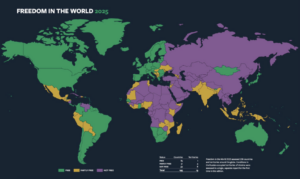In 2019, the European Union (EU) introduced a set of 22 indicators to measure the successes of digital transformation. These indicators were used as a guide by Türkiye to enhance and accelerate digitalization and to put them at the center of everyday life. [1] Aiming at aligning digital transformation with long-term industrial strategy, the initiative focuses on measurable outcomes until 2030. This initiative is designed to drive structural transformation through digital innovation and to develop best practice models which are adaptable to diverse national contexts.
The main purpose was not only digitalizing the institutions or business mechanisms but also making citizen’s life easier, changing the way of life fundamentally to enable all processes efficient across all dimensions. Additionally, digital transformation and technology became increasingly important during Covid-19, as digital solutions played a vital role in minimizing its impact on social life. Coupled with institutional efficiency, in Türkiye, with its young population, there has been a need to drive the transformation towards digitalization to ensure a new digital infrastructure that can respond the needs.
That is to say, digital transformation has been one of the top priorities in the European Union when Commissioner Ursula von der Leyen announced a structural change plan in 2019 like the twin priorities of green and digital transformations for Europe. The central focus was to achieve a structural digital change in EU institutions, economy and society until 2030. Before that, the European Commission has already been preparing the Digital Economy and Society Index (DESI) since 2014 to evaluate the progress on EU performance in digital transformation journey.[2]
Given Türkiye’s long-standing pursuit of European Union accession, it has developed several policies that directly reflect and align with the EU’s strategic priorities in Türkiye’s 11th Development Plan (2019–2023) and National Artificial Intelligence Strategy (2021).[3] In 11th Development Plan, for instance, clear and strong digital transformation priorities were identified and embedded within the plan’s objective of boosting competitive production and productivity, particularly through technology‑intensive sectors such as machinery, electronics, automotive, pharmaceuticals, and others.. There was concrete frameworks for Industry 4.0 development, that was initiated by EU, to accelerate digital transformation in the manufacturing sector, focusing on robotics, internet of things (IoT), big data, augmented reality, and high-tech readiness not only in the 11th but also in the previous one, the 10th Development Plan (2014–2018). A national roadmap was created by the Digital Transformation in Industry Platform and TÜBİTAK (The Scientific and Technological Research Council of Türkiye) and eventually, the Turkish Presidency established “Digital Transformation Office”, which is quite high level in terms of bureaucratic hierarchy, to coordinate all those processes directly under the president in 2018.[4] Türkiye’s Digital Transformation Office has divided into five subtopics: Digital Transformation, Digital Türkiye, Artificial Intelligence, Big Data and Cyber Security.[5]
The goal was building an effective, transparent, participatory, and user-centered e‑Government system, prioritizing data security, integrated service delivery and inclusivity. This was further reinforced by parallel strategic documents: the 2015–2018 Information Society Strategy and the 2016–2019 National e-Government Action Plan, which sought alignment with EU norms in public digital services.
The establishment of the Presidential Digital Transformation Office in 2018, along with complementary efforts across various ministries and organizations, reflects Türkiye’s strong commitment to institutionalizing digital governance. This commitment is also highlighted in international assessments, such as the OECD’s Digital Government Review of Türkiye, which underscores the country’s alignment with evolving global standards—particularly those promoted by the European Union.”
Though not founded as a direct obligation of EU accession, the Digital Transformation Office emerged in a context where it is shaped by Türkiye’s alignment efforts with the EU’s digital agenda and the broader digital single market strategy, as articulated in Chapter 10 of the acquis Communautaire (Information Society and Media). The Presidency of Digital Transformation Office was intended to coordinate cross-sectoral digitalization, improve public service delivery, and ensure interoperability across a number of agencies—mirroring institutional models found in EU member states to make sure that the best practices are well transferred.
However, in practice, the organization has failed to deliver on those aims due to structural and political dynamics in Türkiye. Although the organization was established at the highest level of bureaucracy with strong authority delegated by the presidency, it lacked a legislatively anchored national digital strategy until recently. Its operations relied heavily on top-down executive directives, which were often met with limited enthusiasm by ministries, thereby weakening cross-agency coordination and hindering effective public–private collaboration. As a result, many of its objectives remained largely declaratory and superficial, with few measurable outcomes. Moreover, its initiatives were not well integrated with EU benchmarking tools, such as the Digital Economy and Society Index (DESI), as previously noted. This institutional fragility and to some extent, the lack of coordination among organizations point to a deeper issue: the transfer of policies without adapting the necessary institutional capacity. And this highlights a clear lesson: a policy emulation in the absence of structural reform, can result in institutional stagnation despite formal EU alignment. Although Türkiye adopted the formal framework of EU-aligned digital governance and expressed a commitment to meeting chapter requirements, it failed to implement the reforms or ensure the autonomy required for such institutions to function effectively. Finally, this experience shows us how efforts to emulate EU digital governance norms can result in symbolic compliance and superficial adjustments rather than substantive transformation when not supported by broader institutional reforms.
* İsrafil Özkan
[1] Please see those indicators here: https://www.digitaleurope.org/key-indicators-for-a-stronger-digital-europe/
[2] https://digital-strategy.ec.europa.eu/en/policies/desi
[3] https://www.sbb.gov.tr/kalkinma-planlari/
[5] https://cbddo.gov.tr/hakkimizda/





